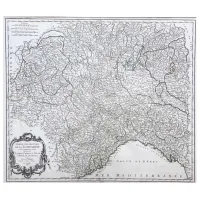Willem Blaeu Territories of Pavia Lodi Novarra Tortona Alessandria and other neighbors of the state Milan 1640 Amsterdam
Luxury antiques
SKU: ANT-A1030
See other products from category Antique prints or from manufacturer Antyki with shipping within 24 hours
Description
Willem Blaew Territories of Pavia, Lodi, Novara, Tortona, Alessandria, and other neighboring states of the State of Milan, 1640, Amsterdam. A geographical map of lower Lombardy and part of Piedmont, with marked provinces of Pavia, Alessandria, and Lodi, featuring a detailed description of river courses and orographic relief. Graduated margin around the entire perimeter, with a grid. At the bottom right, a monumental cartouche topped with a seated female figure with a scepter, crowns, and tiara; various animals on the sides, and a graphic scale below. Vertical fold in the middle, in excellent condition, with cardboard and modern frame.
Willem Blaew was an author, printer, and publisher of maps and globes, who signed his works as Guljelmus Caesius until 1621. From 1594 to 1596, he was a student and friend of Tycho Brahe (1546–1601), from whom he acquired astronomical knowledge that he used in his own work. Blaeu benefited from the support of scientists and geographers who collected original maps for him. Although he was educated, he was not always able to assess the accuracy of his maps and often relied on information contained in incomplete and inaccurate travel reports. On January 3, 1633, he was appointed the official cartographer of the Dutch East India Company, and because he had printing equipment, he could regularly produce national maps in atlas format, some of which appeared in the Atlas Novus, published in 1635.
Beautiful antique furniture and accessories can be an excellent idea for decorating our interiors. Today, there are more and more enthusiasts of high-quality old products that have a specific character and soul. It is a nod to the history, creation, and design of traditional and timeless furniture. There are many different styles in antique furniture, each with its distinctive features.
There are many different styles characterizing antique furniture, but we can distinguish a few of the most important ones. Eclectic furniture belongs to the 19th century, which is dominated by the Biedermeier style. Its variations in the early years of this century include neo-Gothic, Gothic, Rococo, Louis Philippe style, and finally the English Victorian style. By the end of the century, these styles transition into pseudo-styles of classicism, Renaissance, and Baroque.
Beautiful furniture in the Empire style is from the period between the late 18th and early 19th centuries. It all originated from the reign of Napoleon. There, a significant resemblance and references to Roman and Greek decorations were imposed.
Classicist furniture is in the Louis XVI style, which also strongly references ancient architecture. Interesting and noteworthy are all antique products in the Rococo and Louis XV styles. Next is Baroque, whose name comes from the Portuguese barocco – which translates to an irregularly developed pearl. These were very representative pieces of furniture meant to literally ooze splendor and play a significant role in luxury. Exceptional, selectively used materials were employed to further emphasize the lofty tone of these products.
Today, we can observe how much influence the Baroque style had on today's classic furniture, which is designed with great similarity to the past era. Another significant style is the Renaissance, which flourished in the 15th and 16th centuries and also left a large mark on the art of furniture making. The Renaissance style was quite heavy and massive. Brown stains were used, as well as cornices, strong plinths, and bas-reliefs. It can certainly be said that these were quite specific products, but they offered many new possibilities such as the construction of sideboards or generally broadly understood chest furniture. Here, too, there was an interest in mythology and ancient times, so supports or legs took on animal forms.
Lion paws, eagle heads – these are common sights in the Renaissance style. Currently, many global brands recreate such furniture, taking examples from Italian or French creators. It is a manifestation of admiration and care for the history of the most beautiful Renaissance antiques. It is important to remember that in each country, furniture making was perceived differently, so each style in a given country had its own distinct character. This is very important, especially when searching for the right luxury antique for your interior.
The most important aspect of stylish antique furniture is originality. This is ultimately crucial from the customer's perspective, as there are many counterfeits circulating in the market. The Luxury Products brand provides a document confirming the product's compliance with the actual description and photo. We offer the services of art appraisers, historians, and experts from around the world.
Attributes / Details
| SKU | ANT-A1030 |
| Manufacturer | Antyki |
| Model | A1030 |
| Material | cardboard, wood |
| Size | Height: 38 (69) cm Width: 49.5 (77.5) cm Depth: 2 cm |
| Wiek | XVII |
| Rok | 1600 |
| Destiny | To office |
See catalog
Reviews
No reviews for this product.













